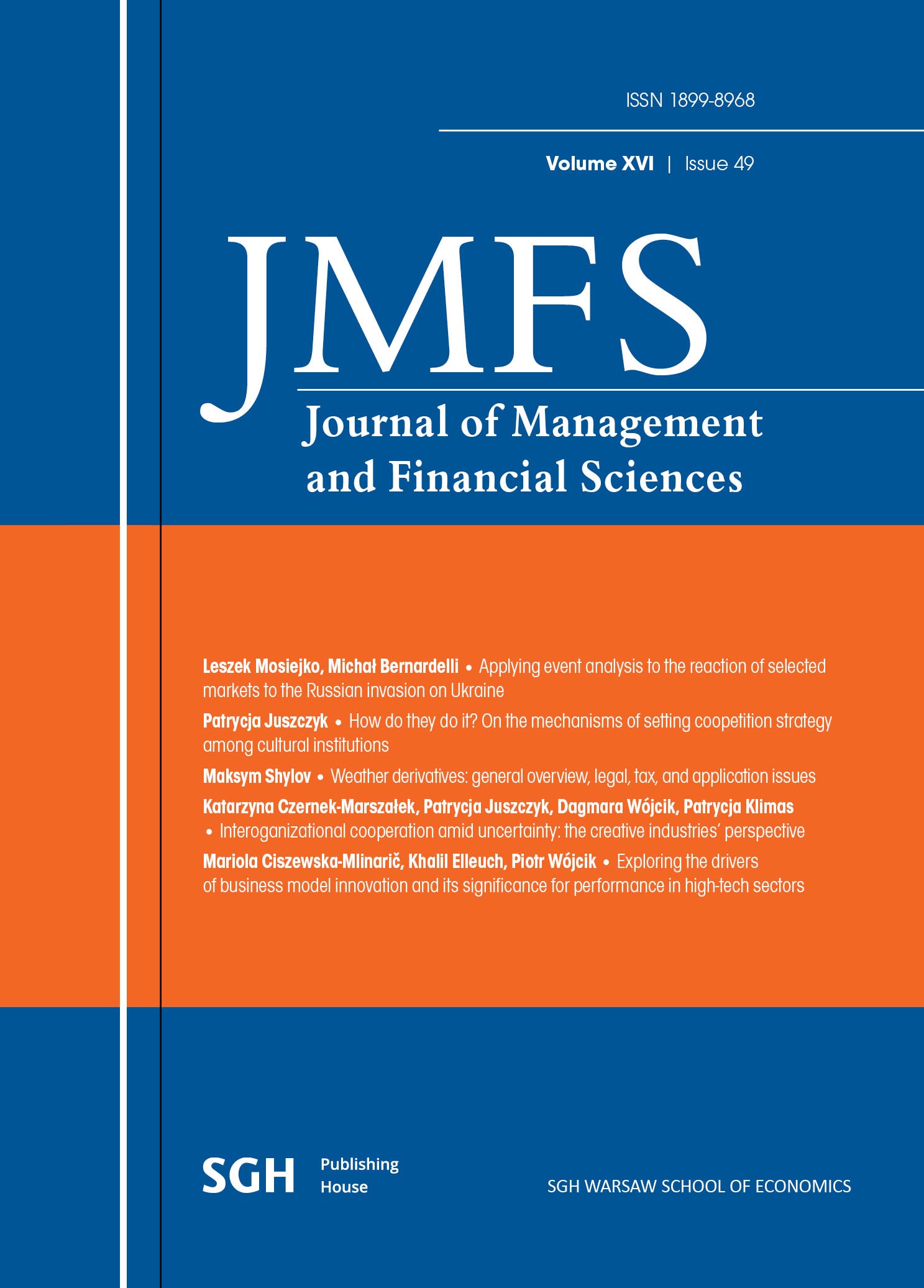Applying event analysis to selected markets’ reaction to the Russian invasion on Ukraine
Main Article Content
Abstract
The aim of the study was to analyse the rate of return of selected stock exchange indices, currency pairs, raw materials and food in the event window determined by the start date of the Russian-Ukrainian war in 2022. The analysis used an approach based on the observation of the development of rates of return and their changes over time caused by Russia’s invasion on Ukraine on February 24, 2022, applying the commonly used Average of Cumulative Abnormal Returns (ACAR) measure. The research showed many similarities as well as some differences in terms of the strength of the impact and the direction of changes in the prices of instruments on individual markets as a result of the outbreak of an armed conflict. The analysis comprehensively takes into account the impact of armed conflict on the development of short- and medium-term rates of return on various markets, the global scope of which has a significant influence on the economic development of individual countries. Not being limited to one market makes it possible to identify universal patterns of stock market behaviour in response to unforeseen events with a global impact on the world economy.
Downloads
Article Details

This work is licensed under a Creative Commons Attribution 4.0 International License.
References
Antonakakis, N., Gupta. R., Kollias. C., Papadamou. S. (2017). Geopolitical Risks and the Oil-Stock Nexus Over 1899–2016. Finance Research Letters, 23.
Balbaa, M., Eshov, M., Ismailova, N. (2022). The Impacts of Russian Ukrainian War on the Global Economy in the frame of digital banking networks and cyberattacks. The 6th International Conference on Future Networks & Distributed Systems (ICFNDS ’22), December 15, 2022, Tashkent, TAS, Uzbekistan. ACM, New York, NY, USA, https://dl.acm.org/doi/
fullHtml/10.1145/3584202.3584223 [accessed: 03.08.2023].
Balcilar, M., Bonato, M., Demirer, R, Gupta, R. (2018). Geopolitical risks and stock market dynamics of the BRICS. Economic Systems, 42.
Ball, R., Brown. P. (1968). An empirical evaluation of accounting income numbers. Journal of Accounting Research, 6 (2).
Benninga, S. (2008). Financial Modelling. 3 rd edition. Cambridge, Massachusetts, London, England: The MIT Press.
Bouoiyour, J., Selmi. R., Hammoudeh. S., Wohar. M. E. (2019). What are the Categories of Geopolitical Risks that Could Drive Oil Prices Higher? Acts Or Threats? Energy Economics, 84.
Buigut, S., Kapar, B. (2020). Effect of Qatar Diplomatic and Economic Isolation On GCC Stock Markets: An Event Study Approach. Finance Research Letters, 37.
Campbell, J. Y., Lo, A. W., MacKinlay, A. C. (1997). The Econometrics of Financial Markets. Princeton: Princeton University Press.
Carow, K. A., Kane, E. J. (2002). Event-study evidence of the value of relaxing long-standing regulatory restraints on banks, 1970–2000. Quarterly Review of Economics and Finance, 42.
Cox, D. R., Peterson, D. R. (1994). Stock returns following large one-day declines: evidence on short-term reversals and longer-term performance. Journal of Finance, 49.
Dolley, J. C. (1933a). Characteristics and procedure of common-stock split-ups. Harvard Business Review, 11 (3).
Dolley, J. C. (1933b). Common-stock split-ups – motives and effects. Harvard Business Review, 12 (1).
Fama, E. F., Fisher, L., Jensen, M. C., Roll, R. (1969). The adjustment of stock prices to new information. International Review, 10.
Gurgul, J. (2012). Analiza zdarzeń na rynkach akcji. Warsawa: Wolters Kluwer.
Hirshleifer, D., Shumway, T. (2003). Good Day Sunshine: Stock Returns and the Weather. Journal of Finance, 58 (3).
Kanas, A. (2005). Pure contagion effects in international banking: the case of BCCI’s failure. Journal of Applied Economics, 8.
Kaplanski, G., Levy, H. (2010). Sentiment and stock prices: The case of aviation disasters. Journal of Financial Economics, 95 (2).
Litvak, K. (2007). The effect of the Sarbanes-Oxley act on non-US companies cross-listed in the US. Journal of Corporate Finance, 13.
Liu, H., Pei, Z., Wei W. (2022). The Impact of Russia -Ukraine War on The U. S. Stock Market – Based on Event Study Methodology BCP Business & Management, 32.
MacKinlay, A. C., (1997). Event Studies in Economics and Finance. Journal of Economics Literature, 35 (1), https://www.jstor.org/stable/2729691 [accessed: 03.08.2023].
Miyajima, H., Yafeh, Y. (2007). Japan’s banking crisis: an event-study perspective. Journal of Banking & Finance, 31.
Obi, P., Waweru, F. M., Nyangu, M. (2023). An Event Study on the Reaction of Equity and Commodity Markets to the Onset of the Russia – Ukraine Conflict. Journal of Risk and Financial Management, 16, p. 256.
Ramiah, V. (2013). Effects of the Boxing Day tsunami on the world capital markets. Review of Quantitative Finance and Accounting, 40 (2).
Saunders, E. M., Jr. (1993). Stock Prices and Wall Street Weather. The American Economic Review, 83 (5).
Shan, L., Gong, S. X. (2012). Investor sentiment and stock returns: Wenchuan Earthquake. Finance Research Letters, 9 (1).
Sun, M., Song, H., Zhang, C. (2022). The Effects of 2022 Russian Invasion of Ukraine on Global Stock Markets: An Event Study Approach, https://ssrn.com/abstract=4051987 [accessed: 29.07.2023].
Yousaf, I., Ritesh Patel, R., Yarovaya, L. (2022). The reaction of G20+ stock markets to the Russia – Ukraine conflict “black-swan” event: Evidence from event study approach. Journal of Behavioral and Experimental Finance, 35, p. 100723.
Internet sources
https://en.wikipedia.org/wiki/CAC_40 [accessed: 03.08.2023].
https://en.wikipedia.org/wiki/DAX, [accessed: 03.08.2023].
https://en.wikipedia.org/wiki/FTSE_250_Index, [accessed: 03.08.2023].
https://gpwbenchmark.pl/notowania, [accessed: 02.08.2023].
https://www.britannica.com/money/SandP-500, [accessed: 02.08.2023].
https://www.nasdaqomxnordic.com/index/index_info?Instrument=LT0000999963, [accessed: 03.09.2023].
https://www.nasdaqomxnordic.com/index/index_info?Instrument=LV0007100017, [accessed: 03.09.2023].
